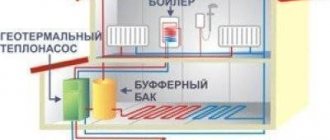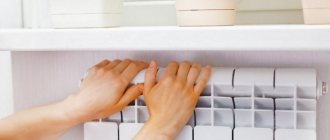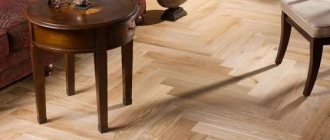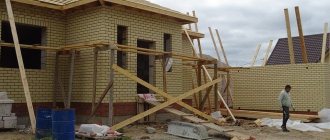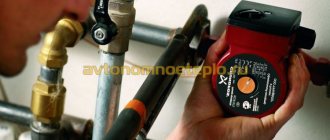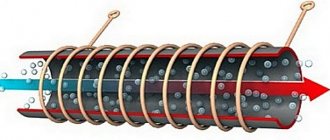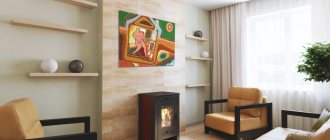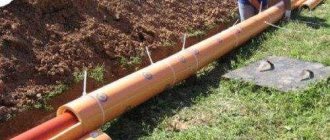A modern home needs a high-quality ventilation system. It's a matter of health and wellness—everyone wants to breathe clean, fresh, pathogen-free air. It turned out that the house was built in a small village quite far from the city and its main communications. Moreover, in Russian conditions, housing also needs to be heated for a significant part of the year.
So, we built a frame house with an area of 200 square meters with a well-designed ventilation system, and only electricity as a heat source. The choice of heating system seemed obvious - we decided to go with an air-to-air heat pump, compatible with ventilation.
Why not firewood?
Our neighbors mostly heat wood stoves, but initially we didn’t like this option. Every year you need to stock up on fuel, clean the boiler, and monitor its combustion. With electricity, everything is much simpler - I pressed the switch, the heat came. The only disadvantage of this method is the high cost of electricity. At the time the heating system was launched, a kilowatt-hour in the Moscow region cost 5.29 rubles.
Naturally, we wanted to use such a valuable resource as economically as possible, so we settled on an air-to-air heat pump. This is the cheapest option and works almost like an air conditioner.
Tips for choosing air conditioners
Before purchasing a split system for home use or office use, you must first decide whether ventilation is needed. Perhaps the room is equipped with an effective ventilation system and does not need additional devices of this type.
If air exchange is weak, pay attention to models of supply air conditioners.
For rooms with high ceilings, any built-in models are suitable - duct, cassette. But do not forget that to disguise the working elements you will have to erect a suspended structure
If the ceilings are low (for example, 2.5 m), the idea of ceiling models will not suit you. Perhaps, based on the technical characteristics, it is possible to select a device with a wall-mounted module, which simultaneously introduces air from the street.
For larger rooms, a more efficient model will be required, for example, with a floor-ceiling installation. Hotel lobbies, foyers and lobbies are characterized by large volumes. In addition to duct systems, column models are installed in them, characterized by productivity and high air exchange rates.
Regardless of the type of device, it is necessary to analyze its technical characteristics and performance characteristics: clarify what area the model is designed for, what its power is, whether it is possible to connect additional modules.
The latest programmable air conditioners with a large list of additional options are much more expensive, but some features are truly important.
The following article, which contains information with answers to questions from potential buyers, will introduce you to guidelines for choosing a split system for furnishing a country house or a city apartment.
Equipment operating parameters
Severe frosts in the Moscow region are rare; experience has shown that the temperature rarely drops below -25℃. We calculated that in such conditions, a pump producing 15 kW of heat would be sufficient for a house with the available space. The system budget cost us approximately 150,000 rubles.
The efficiency of air pumps also varies depending on external conditions. In our case, it turned out that when consuming 1 kilowatt-hour of electricity, the system produced 2-2.5 kW of heat. It's minimum. If there is a slight thaw outside with a temperature just above zero, then it produces 3.5 kW of heat.
The house is heated evenly by warm air; there are no radiators or heated floors. Fresh street air is constantly added to the system through a recuperator.
The purpose of the recuperator is to further save heat. With its help, the air coming from the street is heated by the air that is forcibly emitted from the house, for example, from the bathrooms. The desired room temperature is set on the remote control.
The control is automatic; at night the temperature is reduced for greater comfort.
Reviews from real owners from Russia
Ignat Gavrilyuk, Ekaterinburg
I live in the Krasnodar Territory, I have a house of 150 sq. m. m. For two years they heated with electricity, the average consumption per season was 3.8 kW/hour. This includes the refrigerator, washing machine and other household appliances. Then, on the advice of friends, they installed an air-to-air heat pump (I would like a geothermal one, but money is tight).
As a result, consumption dropped to 2.7 kW/hour. Then I calculated exactly how much we spent on heating - it turned out that heating with convectors is one and a half times more expensive than using a heat pump. It turned out that in 4-5 years it will pay off, and then there will be net benefit.
Ekaterina Evgenievna, Novosibirsk, Russia
We thought for a long time about how to heat the house - electricity is unprofitable, gas is expensive, and wood or pellets are inconvenient. After rummaging around on the Internet, my husband and I decided to buy an air-to-air heat pump.
There were no problems with the installation, it warmed up perfectly in the fall, and when the cold weather set in, it stopped coping. As a result, we had to install convectors. After two seasons, my husband summed up the results: there is a benefit, but given the cost of the heat pump and convectors, they will pay for themselves in 10 years.
Nikolay A. Krasnoyarsk
I read a lot of squabbles on the forums, and decided to leave my review about the air-to-air heat pump. I am the owner of a house of 240 square meters, I have been using two 12 kW inverter units for 4 years.
In the first season, during severe frosts, the temperature dropped to +18, but the façade was insulated and the problem disappeared. Then there were only advantages - the main thing is to leave them on if you leave home for a long time.
Regarding payback, that’s a separate conversation. Everyone only considers the heating season, but in the summer there are costs for operating air conditioners. An air source heat pump has a higher efficiency and requires less electricity to cool the house.
Over the past year, I summarized the statistics - the ratio of savings in winter and summer is approximately 1 to 3. It turns out that to calculate real savings, take the indicators for the heating season and multiply by 1.33. That's math!
Almost all modern models of air-to-air heat pumps can operate for both heating and cooling.
Gleb Akhverdov, Moscow
There is a small service station with 2 lifts. The ceilings are high, there is no point in warming up the room and insulating it - people don’t live in it. We thought about installing simple air conditioners, but on the Internet I came across an analogue - air heat pumps.
The only problem is that there are drafts in the room and the box is often open. Now, if only it was insulated and the gates were locked... It’s difficult to warm up the room itself, but they installed fan coil units to blow air into the place where the guys work.
We installed two 10 kW units, one for each lift. The craftsmen couldn’t be happier, but I decided to do the calculations; for the season it turned out to be something like 7500-8000 kW. In addition, power tools still work, so the figure is actually lower. I looked at how much it would cost for infrared heaters and convectors - the savings are one and a half to two times. With large consumption, a serious amount results.
A. Alekseev, Moscow region
There is a small house, made of aerated concrete, well insulated, with an area of 140 meters. An air source heat pump is enough. At first I had to fork out money, but in the end it paid for itself in 3 years.
I don’t think that everyone will have such a payback period - my house is thoroughly insulated, and aerated concrete blocks retain heat well. Plus 3-chamber double-glazed windows.
Nikolay Alexandrovich, Sverdlovsk region
Friends recommended a ground-to-water heat pump, but drilling wells is expensive here - the soil is rocky, and there is not enough space to lay horizontal pipes. I had to settle on an air source heat pump (I heat the water in the kitchen and bathroom with a boiler).
I found an acceptable option for 16 kW of thermal power (house of 200 square meters). The company delivered and then disappeared in an unknown direction. When winter came, it turned out that only a third of the house could be heated properly.
When I called the normal craftsmen, they said that they sold me a Chinese unit that was dying and did not produce normal power. So be careful when choosing a supplier!
This is what the indoor unit of an air-to-air heat pump looks like.
Heat distribution across rooms
Each room needs its own amount of heat. For example, corner rooms always require more of it, because they have two cold walls. We solved the distribution problem using valves.
In other places, the supply is regulated by valves on the grates. They stand not only in the ceiling, but also in the floor. This is very important for uniform heating and comfort - everyone knows that warm air rises. The air intake for exhaust from the premises is arranged in a similar way - it is produced both from the ceiling and from the floor.
It has already been mentioned how air is removed from the bathrooms: to the street through a recuperator, so odors do not spread throughout the house.
Comparison of conventional and supply air conditioners
A common mistake among users is that they consider any air conditioning system to be a ventilation system. In fact, only some types of equipment can operate in active air exchange mode with street air masses. To make it clearer, let’s first consider the design of a conventional split system.
Air conditioners for domestic use, which are commonly called split systems, are a set of two separate modules that have a different structure from each other and are located in different places.
The first module is an evaporation unit, which is installed on the floor, hung on the wall or partially masked with ceiling cladding. The second module is a remote compressor-condensing device, usually mounted on the facade of a building.
Schematic representation of a device with an internal module mounted on the wall. The two modules are connected to each other by thin copper tubes through which freon moves. The tubes are hidden in grooves behind decorative trim or in plastic boxes (+)
The operating principle of the air conditioner is simple. Through the intake grilles, room air enters the unit, where it is cooled, and then removed through the air ducts to the outside. The change in air temperature is based not on the production of cold, but on the transfer of thermal energy.
The carrier is freon, which enters the remote module in a gaseous state and returns in a liquid state. To enter the gaseous phase, freon takes some of the heat from the exhaust air in the evaporator.
In fact, no replacement of air masses occurs, and cooling (as well as heating and filtration) is carried out by recirculation. The supply equipment is designed differently. An example of a split system with the organization of fresh air flow is a duct-type device.
Design diagram of a ducted air conditioner, which performs the functions of ventilation and temperature control indoors. A mandatory design element is a heater built into the pipe (+)
Of course, ordinary split systems are easy to install, have many additional functions, and have a beautiful modern design, but, unlike supply air systems, they do not refresh the air in the room - and this is their main disadvantage.
External part
The outdoor heat pump unit sits behind air-transparent blinds. It is quite large and looks like an industrial air conditioner. In winter, the pump housing freezes and becomes covered with a thick coat of snow. This is a process provided for in its operation - according to its internal algorithms, the equipment regularly goes to defrost and completely thaws. After this everything repeats itself.
Operating principle
The operating principle of an air-to-air heat pump is based on the same physical phenomenon that underlies the functioning of refrigeration equipment. Only in this case it is applied in reverse. The refrigerator removes heat from the space inside its body, and you can notice that the radiator grille located outside it heats up.
The sequence of actions of an air-to-air heat pump is as follows:
- A fan driven by an electric motor draws outside air into the unit housing. It enters the heat exchange system, where, upon contact with the tubes through which the refrigerant flows, it releases thermal energy. As a result, the refrigerant changes its state of aggregation from liquid to gaseous.
- At the next stage, the resulting gas enters the compressor, where it is compressed, which is accompanied by even greater heating.
- After this, in the condenser already located in the heated room, a reverse transition of gas into liquid occurs with the release of thermal energy, which is used to heat the room.
- At the final stage, liquid freon is again sent to the external heat exchange system, and the previously built-up pressure is released through a special valve.
All these operations are repeated cyclically.
The temperature of the refrigerant, as a rule, is always lower than the ambient temperature and it always receives thermal energy from the street. However, in severe frosts, the efficiency of this heating method will be quite low.
Conclusions based on the results of use
The entire turnkey ventilation and heating system cost about 280,000 rubles. Here we must take into account that the work was carried out on our own, and when purchasing equipment and materials, the talents of “knocking out” discounts were used to the maximum.
Many do not believe that in our latitudes it is possible to heat ourselves with air heated by electricity. From our own experience we can say that this is real. Such systems work and even allow you to save money. Our average monthly heating bill is 6,000-8,000 rubles. From the experience of neighbors with houses of similar size, we know that they pay both 20,000 and 25,000 rubles per month. It turns out that all our costs for installing an air-to-air heat pump will be fully recouped in about 2 years.
Heat pumps and the renewable energy boom
The use of renewable energy sources has been in the spotlight of the world community for several years.
Today, these alternative energy technologies have become an integral part of our daily lives, no longer just scientific know-how of the future. With the growing popularity of renewable energy sources, modern technologies offer a wide range of appliances designed to meet and to some extent exceed expectations for clean energy solutions. From solar panels and photovoltaic systems to condensing boilers and heat pumps , everyone has the freedom to choose which of these renewable technologies will best meet a household's energy needs without putting an additional strain on their budget. Thus, if there is a sincere desire to go green and even save on energy and heating bills, then there should be no doubt about the advisability of purchasing a green energy device.
If you're interested in finding out how much any of these renewable energy solutions would cost, you can submit a contact form with your preferences. We will contact you as soon as possible for further information and will put you in touch with our qualified suppliers free of charge. No obligation service.
What happens if the electricity goes out?
In the event of a power outage, your home heat pump will eventually stop working... like any other modern heating gas, diesel or pellet boiler, which cannot operate without power from the control automation. The solution here is quite simple - an autonomous gasoline or diesel generator. At a cost of 200-300 dollars, this solution is the most optimal. h2 Emergency situations and breakdowns.
Any, even the most reliable equipment, can fail; no one is immune from this. What is really important is the time it takes for the service department to respond and fix the breakdown. Specialists of Nova Gros LLC travel to any point in Belarus within 24 hours, all main components and spare parts are stored in our warehouse.
Also, all HP produced by Stiebel Eltron have a built-in backup electric heater installed. It allows you to maintain an acceptable temperature in the building in case of compressor failure, freon leakage, damage to the external collector and other breakdowns.
Nova Gros LLC - Official service and warranty center of Stiebel Eltron
Connect with us
Connect with us
How to choose an air-to-air heat pump
The market offers several types of TN. Moreover, each of the models has a certain set of characteristics that affect the possibilities of application. When selecting equipment, you need to pay attention to the following parameters:
- Heat pump performance.
- Manufacturer company.
- The price of both the equipment itself and its installation.
The presence of additional functions matters. For example, some models can not only heat, but also cool the air. In cold regions, it is preferable to use devices with built-in electric or water heaters.
Simply put, the characteristics of the equipment must match the operational parameters of the building in which the installation will be performed. Therefore, when choosing a pump, it is necessary to consult with professionals.
Installation Features
First of all, it is worth noting that the installation of such systems requires certain qualifications of craftsmen and it is better that it is carried out by professionals. The heat pump diagram of an air-to-air system assumes the presence of two blocks, external and internal. The entire structure is quite lightweight, which allows the external block to be installed even on top of roofing material, such as tiles.
When placing the indoor unit, you must be guided by the principle of maximum efficiency of heated air circulation throughout the room. Its installation can be done both on the wall and on the ceiling.
The use of air heating as the main source of heating the room involves the creation of a complex branched system of air ducts
The length and location of air ducts must be carefully calculated by specialist installers. The optimal solution to disguise them would be to install suspended ceilings.

